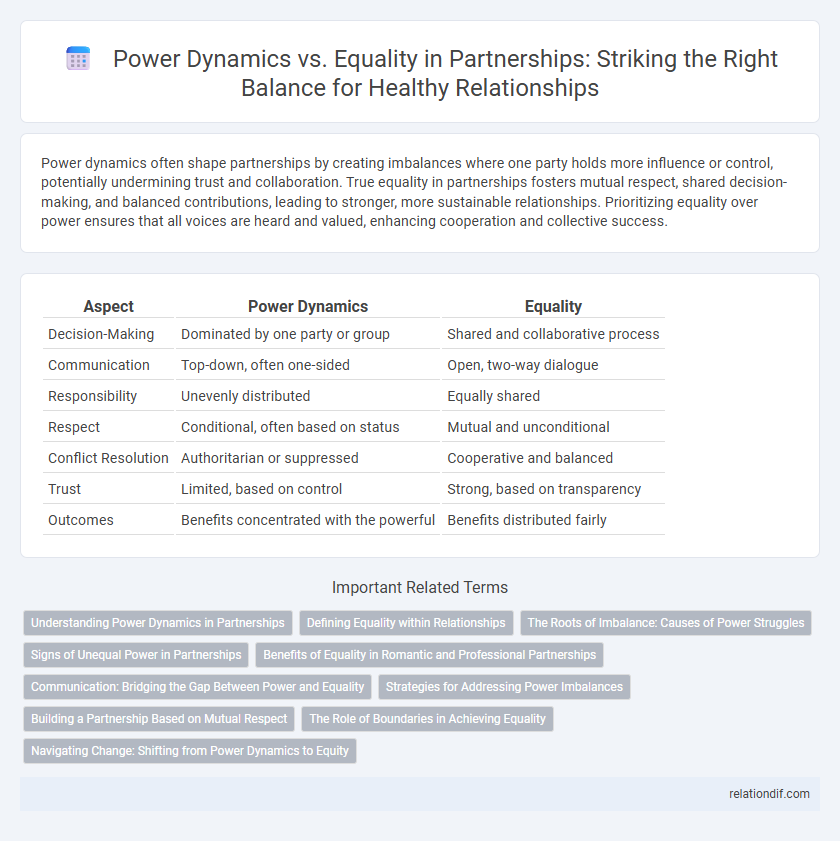Power dynamics often shape partnerships by creating imbalances where one party holds more influence or control, potentially undermining trust and collaboration. True equality in partnerships fosters mutual respect, shared decision-making, and balanced contributions, leading to stronger, more sustainable relationships. Prioritizing equality over power ensures that all voices are heard and valued, enhancing cooperation and collective success.
Table of Comparison
| Aspect | Power Dynamics | Equality |
|---|---|---|
| Decision-Making | Dominated by one party or group | Shared and collaborative process |
| Communication | Top-down, often one-sided | Open, two-way dialogue |
| Responsibility | Unevenly distributed | Equally shared |
| Respect | Conditional, often based on status | Mutual and unconditional |
| Conflict Resolution | Authoritarian or suppressed | Cooperative and balanced |
| Trust | Limited, based on control | Strong, based on transparency |
| Outcomes | Benefits concentrated with the powerful | Benefits distributed fairly |
Understanding Power Dynamics in Partnerships
Understanding power dynamics in partnerships is crucial for fostering equality and mutual respect. Power imbalances can influence decision-making processes, communication patterns, and the distribution of resources, often leading to conflicts or dissatisfaction. Recognizing and addressing these dynamics enables partners to create a balanced relationship where each voice is valued and contributions are equitable.
Defining Equality within Relationships
Defining equality within relationships involves recognizing mutual respect, shared decision-making power, and balanced responsibilities between partners. Power dynamics shift when both individuals have an equal voice, influence, and autonomy, fostering trust and collaboration. Establishing clear boundaries and valuing each other's perspectives ensures that equality becomes the foundation for sustainable and healthy partnerships.
The Roots of Imbalance: Causes of Power Struggles
Power struggles in partnerships often stem from deeply ingrained social hierarchies and unequal access to resources or decision-making authority. Emotional insecurities and past experiences can exacerbate dominance behaviors, creating cycles of control and resistance. Recognizing these root causes is essential for fostering genuine equality and mutual respect within collaborative relationships.
Signs of Unequal Power in Partnerships
Unequal power in partnerships often manifests through one partner making most decisions, controlling finances, or dictating social interactions. Frequent disregard for one partner's opinions and emotional needs signals imbalance and potential domination. Persistent patterns of manipulation, intimidation, or lack of mutual respect highlight deeper power disparities undermining equality.
Benefits of Equality in Romantic and Professional Partnerships
Equality in romantic and professional partnerships fosters mutual respect, enhancing communication and trust between partners. Balanced power dynamics contribute to shared decision-making, increased satisfaction, and collaboration, which drives personal growth and collective success. Emphasizing equality reduces conflicts and promotes an environment where both parties feel valued and empowered.
Communication: Bridging the Gap Between Power and Equality
Effective communication serves as the cornerstone for balancing power dynamics and fostering equality in partnerships by ensuring transparency, active listening, and mutual respect. Open dialogue mitigates misunderstandings and redistributes influence, enabling all parties to voice concerns and contribute equally. Strategic communication frameworks, such as structured feedback loops and conflict resolution practices, reinforce equitable exchanges and dismantle hierarchical barriers.
Strategies for Addressing Power Imbalances
Effective strategies for addressing power imbalances in partnerships involve transparent communication and shared decision-making processes to ensure all parties feel valued and heard. Implementing regular feedback mechanisms and equitable resource allocation helps redistribute influence, fostering collaboration and trust. Establishing clear roles and responsibilities alongside mutual accountability promotes a balanced partnership where power dynamics are managed constructively.
Building a Partnership Based on Mutual Respect
Building a partnership based on mutual respect requires acknowledging and addressing power dynamics to create an environment where all voices are valued equally. Effective collaboration thrives when partners share decision-making authority and openly communicate their needs and boundaries. Prioritizing transparency and empathy fosters trust, enabling a balanced relationship that leverages each partner's strengths for collective success.
The Role of Boundaries in Achieving Equality
Establishing clear boundaries is essential for balancing power dynamics and fostering equality in partnerships. Boundaries define acceptable behaviors and responsibilities, preventing dominance by one party while promoting mutual respect. Consistent enforcement of these boundaries ensures that all partners have an equal voice and influence within the relationship.
Navigating Change: Shifting from Power Dynamics to Equity
Navigating change in partnerships requires a deliberate shift from traditional power dynamics to a foundation of equity and mutual respect. Emphasizing shared decision-making and transparent communication fosters an environment where all parties feel valued and empowered. Prioritizing equity enhances collaboration, driving sustainable growth and innovation within the partnership.
Power Dynamics vs Equality Infographic

 relationdif.com
relationdif.com